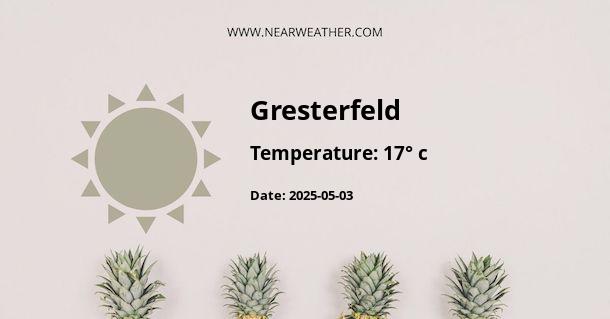Climate and Weather Overview of Gresterfeld, Germany
Gresterfeld, Germany, like many towns in the country, experiences a temperate oceanic climate characterized by mild temperatures, moderate rainfall, and distinct seasons. In this detailed look at Gresterfeld's climate and weather patterns, we'll explore the various meteorological elements that influence the local weather year-round. This will include temperature trends, precipitation levels, and unique weather phenomena specific to this region of Germany.
Seasonal Climate Breakdown
Spring
- Temperature: Spring in Gresterfeld sees a gradual warming pattern. Average temperatures typically range from lows of 2°C in March to highs around 18°C in May.
- Precipitation: Rainfall is relatively moderate, with totals increasing as the season progresses.
- Weatherscape: The landscape transitions from the dormancy of winter to the blossoming of plant life, painting the town in vibrant colors.
Summer
- Temperature: Summertime features warm temperatures averaging between 15°C to 25°C. Heatwaves can occasionally occur, pushing temperatures higher.
- Precipitation: Summer is also the season with the heaviest rainfall, particularly in the form of thunderstorms that can cause sudden downpours.
- Sunshine: Gresterfeld enjoys long daylight hours with an abundance of sunny days, making it ideal for outdoor activities.
Autumn
- Temperature: As autumn sets in, temperatures cool down, ranging from 10°C to 3°C as winter approaches.
- Precipitation: Rainfall decreases during this period, but occasional heavy showers can occur, and the first frosts may appear.
- Scenery: The autumn foliage provides picturesque scenery with shades of orange and red.
Winter
- Temperature: Winters are cold, with temperatures often hovering around 0°C, occasionally dipping below freezing.
- Precipitation: Snowfall is possible, particularly in January and February, contributing to a scenic winter wonderland.
- Daylight: Days are short, and the weather can be quite gloomy with overcast skies being common.
Annual Weather Statistics
According to the Köppen climate classification, Gresterfeld falls under the Cfb category, indicating it experiences a temperate oceanic climate without a dry season and with warm summers.
Temperature
| Month | Average Low (°C) | Average High (°C) |
|---|---|---|
| January | -2 | 3 |
| February | -1 | 4 |
| December | -1 | 3 |
Precipitation
| Month | Rainfall (mm) |
|---|---|
| January | 60 |
| February | 45 |
| December | 70 |
Extreme Weather and Climate Hazards
In recent years, Gresterfeld, like much of Europe, has experienced an increase in extreme weather events. Climate change has led to more frequent and intense heatwaves, particularly in the summer months. Heavy rainfall and thunderstorms have also become more common, occasionally leading to localized flooding. Additionally, as global temperatures rise, winters have become milder with less frequent snowfall, a trend that impacts both local ecosystems and winter recreational activities.
Advice for Visitors and Residents
- Spring: Pack layers to accommodate fluctuating temperatures and a waterproof jacket for rain showers.
- Summer: Bring sunscreen and light clothing for hotter days, and be prepared for occasional thunderstorms.
- Autumn: As temperatures drop, warm clothing is essential, and an umbrella can come in handy for the rain.
- Winter: Ensure you have warm outerwear and consider snow-appropriate footwear if planning outdoor activities.
Impact of Climate on Local Culture and Economy
The climate and weather in Gresterfeld significantly influence the local culture and economy. Agriculture, a vital part of the local economy, depends heavily on the seasonal weather patterns, with crops such as hops and barley being sensitive to changes in temperature and precipitation. Furthermore, the traditional festivities, including outdoor Christmas markets, rely on the seasonal weather to create the perfect festive atmosphere.
Climate also shapes recreational activities. Warm summers allow for hiking, cycling, and water sports, while cold winters historically have supported seasonal sports like ice skating and skiing. With climate change potentially altering these conditions, adaptations may become necessary to sustain these cultural practices and economic activities.
Long-Term Climate Trends and Observations
Long-term climate data for Gresterfeld indicates a slow but steady increase in average temperatures, in line with global trends. Over the past few decades, Gresterfeld has seen gradual changes to its climate, with milder winters and extended summer seasons. This warming trend has implications for local biodiversity, with shifts in species' distributions and behavior patterns.
Climate scientists and meteorologists continue to monitor these shifts closely, using advanced modeling techniques to predict future changes. Community initiatives are also underway to mitigate the impacts of climate change, emphasizing sustainable practices and bolstering the town's resilience against extreme weather events.
Conclusion
The climate and weather of Gresterfeld, Germany portray a microcosm of the larger global climate dynamics. Understanding the nuanced weather patterns and their impact on local life is essential for both residents and visitors aiming to make the most of their time in this charming German town. Whether it is planning a trip to coincide with a favorite season or adapting to the broader implications of climate change, the knowledge of Gresterfeld's climate is invaluable for navigating and appreciating the rich experiences it offers.
A - Gresterfeld's Latitude is 51.983330 & Longitude is 8.716670.
A - Weather in Gresterfeld is 3° today.
A - Climate Conditions in Gresterfeld shows overcast clouds today.
A - Humidity in Gresterfeld is 92% today.
A - Wind speed in Gresterfeld is 24.55 km/h, flowing at 253° wind direction. today.
